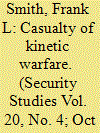| Srl | Item |
| 1 |
ID:
109074


|
|
|
|
|
| Publication |
2011.
|
| Summary/Abstract |
The US military is responsible for protecting its forces from biological weapons. However, the Department of Defense has neglected biodefense-most of the funding for which now comes from civilian organizations rather than traditional military sponsors. Why? I argue that organizational frames explain military neglect and the rise of civilian biodefense. Because the military's frame of reference is defined by kinetic warfare involving projectile weapons and explosives, it neglects non-kinetic capabilities like biodefense. In contrast, the civilian Department of Health and Human Services has a different organizational frame and thus is more amenable to supporting biodefense. I test this theory against realism and bureaucratic interests. I find that research, development, and acquisition for biodefense support the ideational theory of organizational frames, which has important implications regarding the influence of specific ideas on national security policy.
|
|
|
|
|
|
|
|
|
|
|
|
|
|
|
|
| 2 |
ID:
126029


|
|
|
|
|
| Publication |
2012.
|
| Summary/Abstract |
In this article, we analyze feedback from simulated casualties who took part in field exercises involving mass decontamination, to gain an understanding of how responder communication can affect people's experiences of and compliance with decontamination. We analyzed questionnaire data gathered from 402 volunteers using the framework approach, to provide an insight into the public's experiences of decontamination and how these experiences are shaped by the actions of emergency responders. Factors that affected casualties' experiences of the decontamination process included the need for greater practical information and better communication from responders, and the need for privacy. Results support previous findings from small-scale incidents that involved decontamination in showing that participants wanted better communication from responders during the process of decontamination, including more practical information, and that the failure of responders to communicate effectively with members of the public led to anxiety about the decontamination process. The similarity between the findings from the exercises described in this article and previous research into real incidents involving decontamination suggests that field exercises provide a useful way to examine the effect of responder communication strategies on the public's experiences of decontamination. Future exercises should examine in more detail the effect of various communication strategies on the public's experiences of decontamination. This will facilitate the development of evidence-based communication strategies intended to reduce anxiety about decontamination and increase compliance among members of the public during real-life incidents that involve mass decontamination.
|
|
|
|
|
|
|
|
|
|
|
|
|
|
|
|